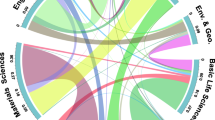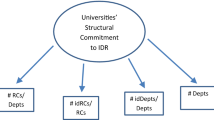Abstract
As a novel tool for evaluating research competences of R&D actors, science overlay maps have recently been introduced in the scientometric literature, with associated measures for assessing the degree of diversification in research profiles. In this study, we continue the elaboration of this approach: based on science overlay maps (called here m-maps), a new type of map is introduced to reveal the competence structure of R&D institutions (i-maps). It is argued, that while m-maps represent the multidisciplinarity of research profiles, i-maps convey the extent of interdisciplinarity realized in them. Upon i-maps, a set of new measures are also proposed to quantify this feature. With these measures in hand, and also as a follow-up to our previous work, we apply these measures to a sample of Hungarian Research Institutions (HROs). Based on the obtained rankings, a principal component analysis is conducted to reveal main structural dimensions of researh portfolios (of HROs) covered by these measures. The position of HROs along these dimensions then allows us to draw a typology of organizations, according to various combinations of inter- and multidisciplinarity characteristic of their performance.



Similar content being viewed by others
Notes
We thank one of the referees for pointing out this issue.
References
Boyack, K. W. (2009). Using detailed maps of science to identify potential collaborations. Scientometrics, 79(1), 27–44.
Leydesdorff, L. (2007). Betweenness centrality as an indicator of the interdisciplinarity of scientific journals. Journal of the American Soceity for Information Science and Technology, 58(9), 1303–1319.
Leydesdorff, L., & Rafols, I. (2009). A global map of science based on the ISI subject categories. Journal of the American Society for Information Science and Technology, 60(2), 348–362.
Leydesdorff, L., & Rafols, I. (2011). Indicators of interdisciplinarity of journals: Diversity, centrality, and citations. Journal of Informetrics, 5(1), 87–100.
Porter, A., Cohen, A., Roessner, D., & Perreault, M. (2007). Measuring researcher interdisciplinarity. Scientometrics, 72(1), 117–147.
Rafols, I., Leydesdorff, L., O’Hare, A., Nightingale, P., & Stirling, A. (2011). How journal rankings can suppress interdisciplinarity. The case of innovation studies in business and management. Arxiv preprint. arXiv:1105.1227.
Rafols, I., & Meyer, M. (2010). Diversity and network coherence as indicators of interdisciplinarity: Case studies in bionanoscience. Scientometrics, 82(2), 263–287.
Rafols, I., Porter, A., & Leydesdorff, L. (2010). Science overlay maps: A new tool for research policy and library management. Journal of the American Society for Information Science and Technology, 61(9), 1871–1887.
Soós, S., & Kampis, G. (2011). Towards a typology of research performance diversity: The case of top Hungarian players. Scientometrics, 87(2), 357–371.
Stirling, A. (2007). A general framework for analysing diversity in science, technology and society. Journal of the Royal Society, Interface, 40(15), 707.
Wagner, C. S., Roessner, J. D., Bobb, K., Klein, J. T., Boyack, K. W., Keyton, J., et al. (2011). Approaches to understanding and measuring interdisciplinary scientific research (IDR): A Review of the Literature. Journal of Informetrics, 5(1), 14–26.
Acknowledgments
We acknowledge the financial support from the Future and Emerging Technologies (FET) programme within the Seventh Framework Programme for Research of the European Commission, under the FET Open grant number 233847 (Dynanets project, www.dynanets.org), as well as the support of the Hungarian Government (Anyos Jedlik programme) through the TexTrend project (www.textrend.org), contract no. NKFP_07_A2 (2007)/TEXTREND. The supports are gratefully acknowledged.
Author information
Authors and Affiliations
Corresponding author
Appendices
Appendix 1
See Table 5.
Appendix 2
See Table 6.
Appendix 3
See Table 7.
Rights and permissions
About this article
Cite this article
Soós, S., Kampis, G. Beyond the basemap of science: mapping multiple structures in research portfolios: evidence from Hungary. Scientometrics 93, 869–891 (2012). https://doi.org/10.1007/s11192-012-0713-x
Received:
Published:
Issue Date:
DOI: https://doi.org/10.1007/s11192-012-0713-x




